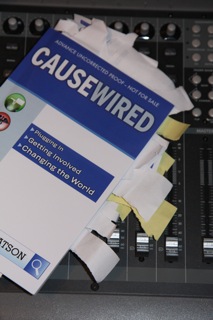Caught by CauseWired
Hang on to the furniture, this post is going to be a bit of a ride. I’m holding Tom Watson and his CauseWired book responsible. I normally read a book very quickly, I’m almost legendary for my tree digesting abilities. I read. I mark with scraps of paper. I digest, note and move on.
If you look at my copy of CauseWired, you’ll see that I’ve marked more than one or two pages out, and if you follow me on Twitter, you’ll know that I’ve been reading it for quite a while. Reading. Thinking. Reading.
It is worth remembering where I am coming from here. I got into the Internet because I was captivated by the power it had to connect people, and the things that happened when it did. I saw technology as a tool for creating positive change.
The companies I have worked for have lead me into commercial business. I’ve worked to create markets, fund companies, sell companies and buy companies, but in parallel to that I’ve also served on the board of trustees for a charity and run with the occasional social cause. I’m no expert on philanthropy or social action, but I do see it as an essential balance to the activities of the commercial world. It is something that the commercially-minded should be actively engaged in. It is no coincidence that some of the richest people on the planet are the greatest philanthropists.
CauseWired, or rather “CauseWired – Plugging in, Getting Involved, Changing the World,” to give the book its full title, makes a big claim. It is about changing the circumstances of others, through your own actions, something that Tom Watson knows about. This particular Tom Watson isn’t the UK MP (here), he’s this one, the US journalist and media critic (fuller bio on the Changing Our World site). There is a link between them, I’ll come back to. The book charts how social networks, like Facebook and a range of more specialist sites, are changing the world of charities/nonprofits and social causes.
Let me take this post as an example of the new dynamic social media (and social networking) is creating. I found out about the book via twitter, got details via a blog post and contacted the publishers via email. I started following Tom, via twitter, as I was interested in his work. Through Twitter I realised that Tom (US) knew Tom (UK), who I’ve followed on twitter since the New York Digital Mission.

I usually post pictures of my travels to photo-sharing site Flickr, and recently posted one of my good self reading CauseWired. Tom commented on the photo, tweeted about it and linked to it in a post on his blog [I hope you are still managing to follow the thread!] The Amazon site picked up that blog post, and so, currently, there I am reading in a picture on the Amazon page for the book (here). I’ve just put that link as my Facebook status update, and… To be continued.
Now, none of that has changed the world, although I’m hoping that someone who reads the book as a result will. However, there are now a few hundred people who know we have a shared interest and skills that can be brought to bear on a cause. Connections and conversations on this kind of global scale would have been unlikely before the web, or more specifically before social media came to the web. Activists can amplify their efforts, create awareness and join forces with like minded individuals. That, in essence, is what CauseWired is about: How new communications technology is revolutionizing the flow of money and talent in the third sector.
The book weaves a course across the short history and global geography of the CauseWired phenomenon. The introduction felt a little long, but I have been buried in much of the subject matter for a long time so that may just be me. Once I was through that, I started busily scribbling notes and pondering deep thoughts.
Reading the book was like seeing from the other side of a two way mirror. I know the technologies and many of the causes that Tom uses as examples, but in telling the inside story, he brings them to life with a new freshness. The smaller examples in the book are even more interesting than the larger ones. Traditional broadcast media often leads the rally for the big causes. Social media has created the bandwidth for the smaller ones to emerge, the ones that don’t get big media air-time, in their early days at least. That is a qualitative change in the way that things work.
The big take aways and aha’s for me:
- There is a big difference between being aware or interested and engaged and active.
- We’ve been doing this stuff ‘forever’ – I remember charitable activity on the Bulletin boards in the 80’s – it is the tools and scale that has changed.
- This is yet another inter-generational fault-line.
- The shift from anonymity to authenticity is high-impact. “On the Internet no-one knows you are a dog” was 90’s. “I am…” is the 00’s.
- The powerful stuff happens when the on-line meet off-line and the off-line comes on-line.
- Tom Watson mentions Tom Watson in the book, in the context of UK open government, a slightly surreal moment.
- There’s more… Which I’ll come back to in future posts.
- Reading this book will be expensive – I’ve added lots of the books mentioned on to my Amazon wish list, and found some interesting causes.
If you’re in business, and you plan to hire or work with millennials, you better have a cause and/or be involved in one. CauseWired is a good place to start to understand that world. This book doesn’t aim to dig into the depths of social media. It isn’t going to lose the uninitiated, and experts shouldn’t expect any great revelations in that domain. It does illuminate wired causes, and provide a wealth of illustrations. If you work for a charity or not-for-profit, read this book. Digest it. Then read it again. It is the new shape of your world.
For our own mental well being, all of us need to be involved in something that transcends the ‘me’ and engages with the ‘us’, something that reaches beyond the ‘now’ to the tomorrow and beyond. If you haven’t done that yet, then Tom’s book will give you insight into what can be achieved, together with a list of places to get engaged in a rewarding way.



Benjamin, thanks for the terrific and very thoughtful review – I agree about the small causes. Those often provided the most insight. I could report this topic endlessly, of course.
And I hope that you do! Time for me to dig into the social enterprise community in the UK some more.
[…] on to geographical political infrastructures: influence. Just as the communities described in Cause Wired were able to organise on-line to create changes in the off-line world on an international level, […]
[…] a mantra for proponents of the power of social networks, and a concept is familiar to readers of CauseWired. Clay’s roots go back deep into the early days of the Internet. He is someone I could have a […]
[…] community of a tool that wasn’t even heard of a year ago. This is mass collaboration at work, CauseWired style. Thousands of people, amplified by technology, making a […]
[…] written about philanthropy, and you might remember that I was Caught by CauseWired. That isn’t the topic here. Zarine was on to broader questions and the nature of business: […]